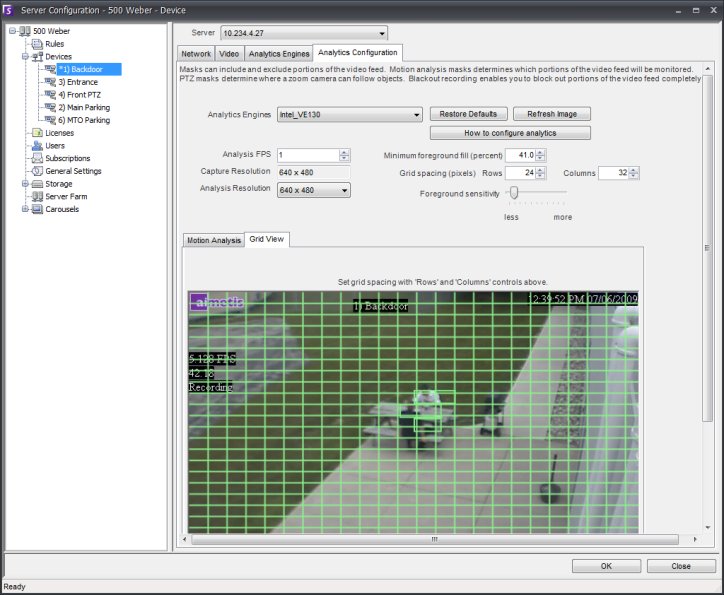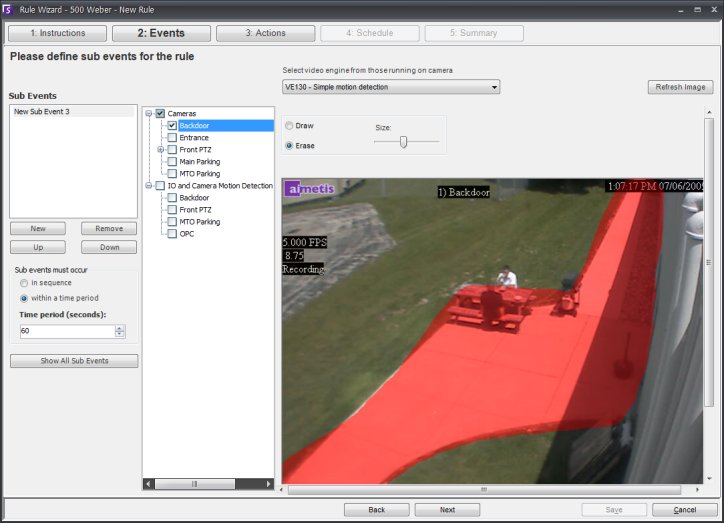
The VE130 is a general purpose video motion detection engine and is good choice for static environments (such as indoors or certain outdoor environments). The VE130 is a good alternative over camera based motion detection due to its simplified configuration and higher accuracy. However, for most outdoor applications, use the VE150 which is designed to work better in adverse weather conditions.
The VE130 is a good choice in indoor and simple outdoor environments where only motion is to be detected and the class of object or object count is not required. Camera position, unlike other video engines, is not heavily constrained, making VE130 a good general purpose video engine in many applications. If object counting or dwell time is required, use the VE150. For outdoor environments, also use VE150 as shadows, lighting changes, etc will cause VE130 to function inaccurately.
Select Server
> Configuration.
Select a camera from the Devices
branch of the left pane.
In the Analytics Engines
tab, select VE130. By default VE250 is selected, in which case you must
first deselect VE250 (see how
to select analytics for more help).
In the Analytics Configuration
tab, select Intel_VE130 from the Analytics
Engines combo box.
In the Motion Analysis
tab, define the area in yellow where objects should be detected. Select
the Erase radio to erase the yellow
mask, and select the Draw radio
to draw the mask. The Size slider
adjusts the pen thickness.
Select the Grid View tab. Normally the default settings and grid spacing is adequate. Move to Step 9 to complete setup or next step to customize the settings.

The following settings can be changed as needed (optional):
|
Analysis FPS |
Frame rate which the video engine analyzes frames. Can be set lower than the record frame rate. |
|
Capture Resolution |
Displays the resolution which the video is being recorded. This can be changed in the Device Setup. |
|
Analysis Resolution |
Resolution which is used to analyze frames. Normally this is lower than the Capture Resolution to conserve CPU. |
|
Minimum foreground fill (percent) |
The scene is divided into a grid. This value specifies how much each grid square must change (in %) before activity is detected in this square. |
|
Grid spacing (pixels) |
Defines grid spacing as Rows and Columns. |
|
Foreground sensitivity |
Defines how sensitive the video engine should be to scene change. The more sensitive it is to change, the more likely the minimum foreground fill will detect activity in the grid space. |
Click OK to save settings.
Configuring the VE130 (see above) is required before creating a Rule that uses the VE130. To configure a Rule using the VE130, follow the steps below:
Open Server
> Configuration > Rules and click New.
Select the camera (if it is a PTZ camera, select the
camera
tour position).
Pick the VE130 from the video engine combo box.
Mark the Alarm zone using the Draw and Erase options. The Size slider changes the drawing or erasing thickness.

Click Next to continue to next step in wizard.
Although the VE130 engine requires less CPU than other video engines, the video still needs to be decompressed in the server for analysis. As a result, the CPU savings are limited.
If too many false alarms are caused by shadows, rain, or other environmental conditions, use the VE150.
See Also